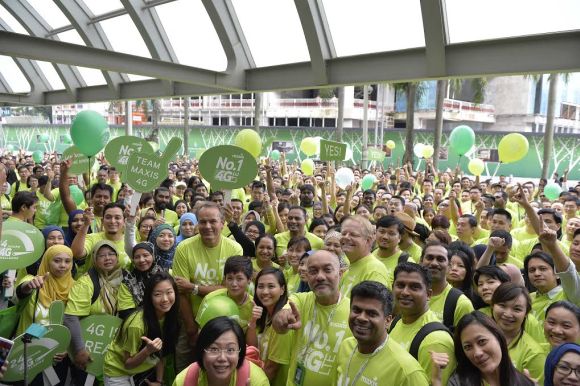Population coverage for 4G LTE has been a hotly debated topic of recent times; at least for two telcos – Digi and Maxis. This overdrawn rally between the two has managed to do one thing, get both their customers rattled up. We’re seeing more negative comments from our readers of late, regarding their own experiences on the two networks. When push comes to shove, what we need are clear outlines on how each cellular provider measures themselves, and this is essentially what Maxis talked about earlier today.
The parameters set by our telcos determine if they’ve set the bar(s) (figuratively) for their network, high enough to be considered acceptable by consumers. Quoting Maxis reps, 4G LTE is currently growing at an alarming rate and to keep up with that upward trend is a tough task but the green telco believes that the standards it has set is more than adequate enough to live up to their claims.
Mentioning briefly that their 4G LTE population coverage is at 62%, placed in 144 locations including state capitals and secondary towns. If you kept track of the current developments, that betters Digi’s numbers by 2%; though there have different levels of signal strength, one being more stringent in their definitions of measurement.
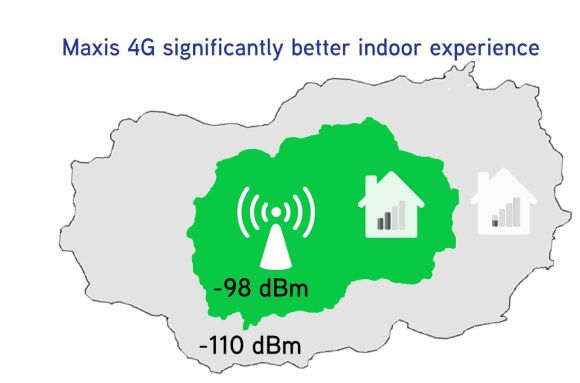
Backed by a desire to provide the most consistent experience across 2G, 3G, 4G and beyond, they’ve established standards that maintain their reputation and position as the best telco to provide a high performing internet experience. If you’re new to the whole debate and the jargon that goes along with it, feel free to read the following:
Signal strength for cellular reception is measured in dBm or decibel-milliwatts
Without digging too deep, this scale of measurement allows us to see how good or bad the reception is
The better the reception, the higher the number, hence -60 dBm is better than -130 dBm
How do telcos do about measuring this reading? Well they head to the very edges and see what they can maintain within an area before dropping to a lower speed aka 4G LTE to 3G. So now that we’ve got that out of the way, Maxis has issued (earlier on) that they measure their signal strength at -98dBm, which on scale, is better than Digi’s -110dBm base of measurement. The former goes on to add that if they followed Digi’s standards, it would easily hit 70% of population coverage.
[nextpage title=”Signal Strength matters”]
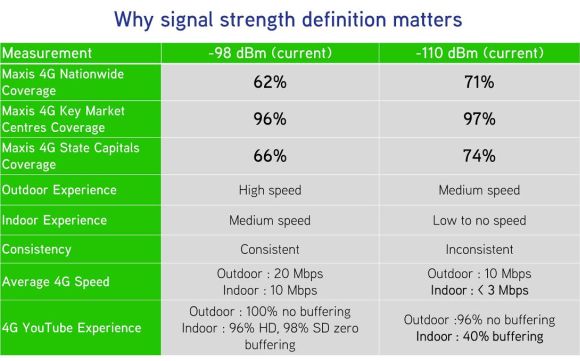
Having sat down with Chief Technology Officer (CTO), Morten Bangsgaard and other heads of network from Maxis, we touched bases on their 4G LTE and general network. We asked why they chose a harder dBm to maintain and their answer was simply because they felt that based on standards, those were the figures they could maintain an acceptable user experience indoors and outdoors. The folks at Tested has already explored signals and what they mean here, so feel free to take a look.
So what parties do telcos in general work with to regulate and provide them insightful feedback? Well, in Malaysia everything that has to do with telecommunication falls under MCMC’s (Malaysian Communications and Multimedia Commission) purview.
Whilst exploring that notion, Mr Bangsgaard shared with us that in the past, telcos needed to put up one 2600MHz base station, per every two 1800MHz tower. The higher the frequency, the better the capacity to support densely populated areas but in turn, it lessens the area span covered. In theory that’s pretty sound but every area has differing needs, thus MCMC is gradually doing away with this requirement.
At the same time, MCMC has opened up the 2600MHz band and allowed re-farming of the 1800MHz spectrum to the major three telcos; Maxis, Digi and Celcom – so you can’t say there isn’t a level platform, in terms of spectrum allocation. They’ve also shared with us that 70% of their cell towers are set to relay 1800MHz, allowing deeper penetration of areas.
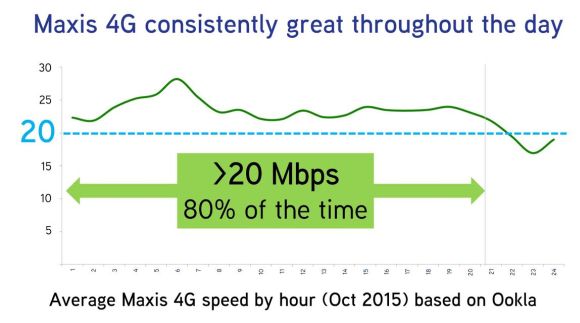
On the other hand, Maxis states that they fetch data from Ookla, the famous people behind Speedtest.net. This information basically comes from all the times you’ve tested your network using the aforementioned site/app; Ookla doesn’t openly publish information anymore – as said by a Maxis network representative but to be helpful to mobile network providers, Ookla does allow its data to be purchased. So if you’ve thought that no research goes into figuring out the problems of their network, you’re wrong – as far as we know, most telcos world-wide utilise data from Ookla itself.
Diving further into information provided by Ookla, when we asked Maxis “would there be any information inside their reports that could be important to consumers?” they replied that “without the necessary knowledge and expertise, the information wouldn’t be the best representation of what the network is capable of, since you’ll need to sift through it to find useful data”.
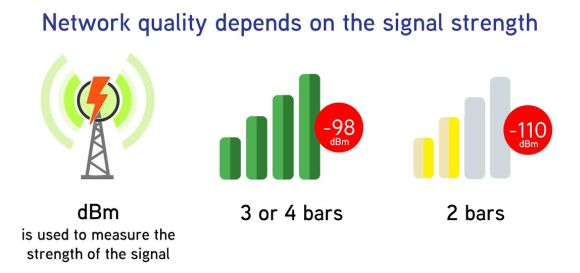
Thus, echoing their sentiments made earlier on during the media press conference; stating that Ookla isn’t the best gauge for testing speeds – since many factors go into delivering those numbers when you test and this information isn’t readily available for the public to view, making it a whole lot more complicated to comprehend.
[nextpage title=”Maxis still needs to buck up”]
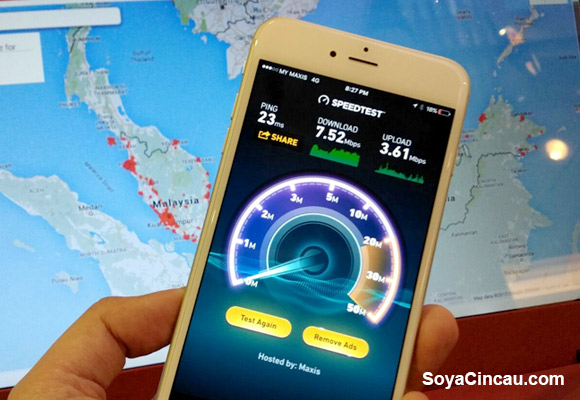
On the surface, what we see from our network providers are merely them delivering results, or lack thereof but we’re unaware of what goes behind the scenes. And in hopes of creating a better platform for consumers to compare their telcos, they hope that sparking the conversation on the quality of 4G LTE, would be a timely topic. They think so at least, since they’re now recording more postpaid costumers making use of their 4G LTE network, so that’s a whole lot of people on their LTE bands – 2.2 million to be exact.
Maxis is open to feedback on their network, as many other local players are, detailing that they set a maximum 7 days to reply the complaint with an appropriate response. Expanding the process to those in attendance, after a complaint has been filed through a dialogue handled by a customer service rep, it then stays in the system if their problem fails to be solved; following which, network guys will take a look and if it still persists they’ll send someone to do a drive-test in the area mentioned – we’ve yet to experience this, so please do share if you have. Their CTO goes on to say that, they’ve also put up temporary miniature towers to solve issues for 3 months, while working on an actual base station at the site itself.
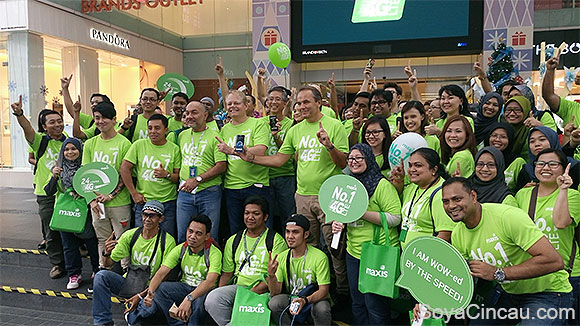
It was refreshing to see Maxis openly talk about everything we touched upon above and we’d hope that other telcos will follow suit, given the opportunity. Despite widening their 4G LTE coverage population, it should be noted that Maxis’ network isn’t full-proof and they have acknowledged the fact, while also taking the necessary steps to rectify these issues. Steps like furthering the optimisation of their network and using the right spectrum that works better indoors – e.g. 1800MHz is 40% better for indoor reception compared to 2600MHz.
For us personally at our office, we struggle receive a stable connection for calls, the basic means of communication; which is quite pathetic. So they’ll definitely be receiving an official complaint from us and we’ll keep everyone updated on how that goes.
Please feel free to reach out to Maxis through their official channels whenever you’re experiencing problems, since if they don’t know, they won’t be able to fix it. Also, please share with us your thoughts on the state of 4G LTE and mobile network providers as a whole, in the comments below.

